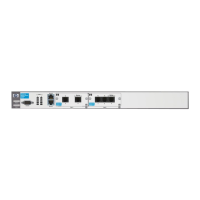8-83
Configuring Demand Routing for Primary ISDN Modules
Quick Start
b. Set the ISDN signaling (switch) type if your service provider is not
using the default setting for your ISDN. For the ISDN BRI U module,
the default setting is isdn switch-type basic-5ess. For the ISDN BRI
S/T modules, the default setting is isdn switch-type basic-net3. If
your service provider is using a different ISDN signaling type, enter:
Syntax: isdn switch-type [basic-5ess | basic-ni | basic-dms | basic-net3]
Table 8-20 lists the command syntax for each signaling type.
Table 8-20. ISDN Signaling Types
c. Set the LDN. (If your public carrier has assigned you a SPID, skip this
step and go to the next step.) Otherwise, enter:
Syntax: isdn ldn1 <number>
Replace <number> with the LDN phone number assigned to the
ISDN line you are configuring. For example, you might enter:
ProCurve(config-bri 1/1)# isdn ldn1 5555551212
d. Set the SPID and LDN. If your public carrier has assigned you a SPID,
you should set the SPID and the LDN at the same time. Enter:
Syntax: isdn spid1 <number> <ldn1>
For example, you might enter:
ProCurve(config-bri 1/1)# isdn spid1 12355512120101 5551212
e. Activate the interface. Enter:
ProCurve(config-bri 1/1)# no shutdown
5. Configure an ISDN group.
a. Create an ISDN group by enter the following command from the
global configuration mode context:
Syntax: isdn-group <number>
Replace <number> with a number between 1 and 255 to uniquely
identify this ISDN group.
Signaling Type Command Syntax
National ISDN-1 isdn switch-type basic-ni
Euro ISDN isdn switch-type basic-net3
Northern Telecom DMS-100 isdn switch-type basic-dms
Lucent/ATT 5ESS isdn switch-type basic-5ess

